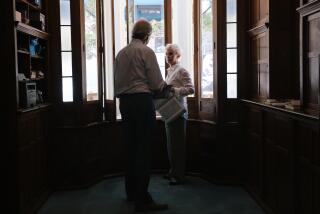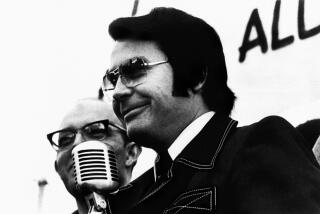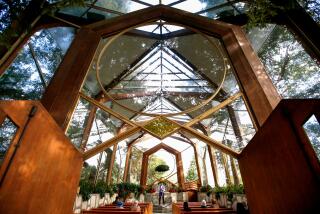Communes Thriving, Study Says : Social issues: Scholars say the counterculture spirituality of 1960s has evolved into an evangelical movement with worshipers across the country.
- Share via
SAN FRANCISCO — Hippies live. So do “Jesus freaks,” many of them in a later incarnation: Christian evangelicals.
Those memorable symbols of the turbulent 1960s in America are alive and well, two American scholars of religion say.
Hundreds of hippie-era communes survived the 1980s and continue to practice and preach a counterculture lifestyle, according to a study by Timothy Miller, a professor of religious studies at the University of Kansas and one of hundreds of scholars who attended a recent gathering here of the American Academy of Religion and the Society of Biblical Literature.
About 6,000 people, including religion professors, Bible scholars, radical lesbian theologians, graduate students and various gadflies of the sacred gathered for the four-day annual meeting that ended Tuesday.
The 1960s spirit of San Francisco’s Haight-Ashbury district is thriving in pockets of activity around the country, said Miller, whose study is called “The Evolution of Hippie Communal Spirituality.”
Brenda Brasher, a researcher from the University of California, charted the growth of the Jesus movement at the annual meeting. She focused on the emergence of the Calvary Chapel in Costa Mesa, which began in 1965 with a few barefoot, longhaired Jesus freaks and is now an emerging evangelical denomination claiming more than 405 congregations and 230,000 worshipers across America.
Hers was one of hundreds of papers presented.
Brasher, whose paper was called “Calvary Chapel: A Jesus Movement Comes of Age,” said the chapel continues to attract young converts, though the movement’s 1960s trappings are less obvious.
Some chapels do have a distinctly countercultural atmosphere, such as a church in Albuquerque, N.M., that has a heavy-metal rock chapel staffed by a longhaired, guitar-playing evangelist, she said.
“You can wear almost anything and go into a Calvary Chapel for worship,” said Brasher, who, along with colleague Donald Miller surveyed 182 pastors in the movement.
Many congregations are splitting off from the movement, Brasher reported, while new congregations are being founded at a rapid pace. She said the movement is now at a crossroads because Calvary Chapel’s founder, the Rev. Chuck Smith, plans to retire soon.
The intense, charismatic commitment in the churches “serves like a springboard for young, motivated clergy,” she said. “They sell their homes, leave jobs and move with their families to plunge into the ministry of Calvary Chapel.”
According to another scholar, Timothy Miller, more than 100 hippie communes survived the 1980s and are populated by variety of types: Jesus freaks, neo-pagans and spiritual environmentalists.
The great majority are organized around some spiritual or ethical principle, he said, and “continue to embody the diverse ethos of the hippies.”
Among the hippie communes that continue to survive is The Farm, founded in 1970 by Stephen Gaskin, a onetime instructor at San Francisco State University. It is described by Miller as “the archetypal hippie commune.” Established in Tennessee after a band of hippies in old school buses decided they had had enough of life on the road, the Farm population peaked later in the decade at about 1,500.
More to Read
Sign up for Essential California
The most important California stories and recommendations in your inbox every morning.
You may occasionally receive promotional content from the Los Angeles Times.










